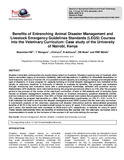Benefits of entrenching animal disaster management and livestock emergency guidelines standards (legs) courses into the veterinary curriculum: case study of the University of Nairobi, Kenya

View/
Date
2015Author
Mutembei, HM
Wangare, T
Kimaru, J
deSouza, N
Mulei, CM
Mbith, PMF
Type
ArticleLanguage
enMetadata
Show full item recordAbstract
D
isaste
r
-
vulnerable communities are
mostly
those reliant on livestock.
Disasters
causing
loss
of
livestock
often
leave a secondary legacy of economic instability, debt and dependency
in addition to
immediate devastation of
food insecurity and
loss of human life
.
It is prudent to build c
apacity
as a
strategy
to
manage and
m
itigate these
type of
disasters
.
A
4
-
year
program for
capacity building
on
animal
disaster management
was
instituted at the
faculty of veterinary medicine
in University of
Nairobi
to evaluate its
benefits
.
The program was evaluated
through m
onitoring and evaluation
tools
and a
post
-
program knowledge, attitudes and practices survey
.
Stakeholders
(270 students
)
were i
n
terview
ed
during the program period and others (n=110)
after the program
period in
the process
of
the review of the veterinary
curriculum. A total of
184 students and 12
lecturers
were
trained on disaster management
modules
,
200
traine
es
on livestock emergency guideline standards (LEGS),
and
two
lecturers as
LEGS trainers.
Over 60% of t
h
ose
i
nterviewed
were aware
the
programs exist
ed
and
o
ver
70%
indicated
the
program had
benefits
(n = 380
)
.
Th
e stakeholders significantly (
n= 270,
P = 0.01
; n=110, P =
0.02) indicated the need to
entrench the
disaster management
and LEGS
courses into the
veterinary
curriculum.
A
cost
-
benefit analysis of
the
veterinary response unit
disaster intervention activity
demonstrated generated
benefits of
$2.74 in the form of avoided
animal
losses for every $1 spent.
If
the time period was extended to 3
and 5
years
, the benefit
-
cost ratio increase
d
to $6.69
and $ 9.21, respectively,
in benefits for every $1 spent.
The
se
results
demonstrate
there are
benefi
ts of
entrench
ing
the
courses
into
the
veterinary
curriculum
and a
recommend
ation is made for
th
e inclusion of
t
he
courses
in all curricul
a
lacking the courses
.
URI
https://profiles.uonbi.ac.ke/hmutembei/files/mutembei_et_al_2015-_benefits_of_dm_and_legs_courses_in_vet_curricula.pdfhttp://hdl.handle.net/11295/93610
Citation
Mutembei, HM., Wangare, T., Kimaru, J ., deSouza, N., Mulei, CM and Mbith, PM (2015). Benefits of entrenching animal disaster management and livestock emergency guidelines standards (legs) courses into the veterinary curriculum: case study of the University of Nairobi, Kenya. Journal of Agricultural Science and Food T echnology, 1(7), pp. 101 - 106Publisher
University of Nairobi
